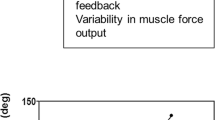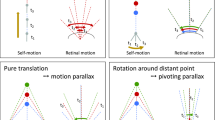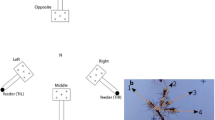Summary
In freely walking flies,Drosophila melanogaster, stationary stripes induce fixation processes. If two vertical black stripes (width 6°) are presented against an illuminated white background and if the two stripes are separated by an angular distance ofα ν < 60°, the flies prefer the direction of the bisector of the angle between the two objects, i.e. the angular distribution of the flies' positions is characterized by one maximum pointing at the center between the two stripes. If two stripes are presented in angular distancesα ν > 75°, the angular distributions of the flies' positions always show two maxima directed towards the two stripes (Fig. 3a). This result is also true for 6°-wide vertical stripes which are illuminated from behind in an otherwise dark drum (Fig. 4a). In experiments with a two- and three-stripesenvironment, the variability of the flies' reactions to the stripes has been measured (Figs. 3–6). From these results, a functiontr (μ) can be deduced which describes the strength of the turning tendencies induced in the flies by a stripe as a function of the walking directionμ of the fly (turning tendency function). This function is characterized (1) by a sharp increase oftr (μ) with increasing angular distance from the direction of the object to the maximum response atμ=25–30°, (2) by a sharp decrease oftr (μ) from the maximum toμ=60°, and (3) by a very slow approach oftr (μ) to the labile zero position of the turning tendency function atμ=±180° (Fig. 7). Additive superposition of two or three of these turning tendency functions, which are phase-shifted for different anglesα ν, allows one sufficiently to describe the walking directions of the flies. This is possible because the stable zero positions of the summation turning tendency functionstr s (μ) coincide with the maxima of all the frequency distributionsf (β) of the flies' positionsβ (Fig. 8).
Similar content being viewed by others
References
Baldus, K.: Experimentelle Untersuchungen über die Entfernungslokalisation der Libellen (Aeschna cyanea). Z. vergl. Physiol.3, 475–505 (1926)
Bathon, H.: Über das Formensehen bei der Verbergeorientierung der Laufkäfer (Coleoptera, Carabidae). Z. Tierpsyohol.32, 337–352 (1973)
Etienne, A. S.: Analyse der schlagauslösenden Bewegungsparameter einer punktförmigen Beuteattrappe bei derAeschna-Larve. Z. vergl. Physiol.64, 71–110 (1969)
Götz, K. G.: The Optomotor Equilibrium of theDrosophila Navigation System. J. comp. Physiol.99, 187–210 (1975)
Götz, K. G., Wenking, H.: Visual control of locomotion in the walking fruitflyDrosophila. J. comp. Physiol.85, 235–266 (1973)
Horn, E.: Die Verarbeitung des Schwerereizes bei der Geotaxis der höheren Bienen (Apidae). J. comp. Physiol.82, 379–406 (1973)
Horn, E.: The contributions of different gravity receptors on gravity orientation in insects. Fortschr. Zool.23, 1–20 (1975)
Jander, R.: Grundleistungen der Licht- und Schwereorientierung von Insekten. Z. vergl. Physiol.47, 381–430 (1963)
Jander, R., Fabritius, M., Fabritius, M.: Die Bedeutung von Gliederung und Kantenrichtung für die visuelle Formenunterscheidung der WespeDolichovespula saxonica am Flugloch. Z. Tierpsychol.27, 881–893 (1970)
Jander, R., Schweder, M.: Über das Formenunterscheidungsvermögen der SchmeißfliegeCalliphora erythrocephala. Z. vergl. Physiol.72, 186–196 (1971)
Jander, R., Volk-Heinrichs, I.: Das strauch-spezifische visuelle Perzeptor-System der Stabheuschrecke (Carausius morosus). Z. vergl. Physiol.70, 425–447 (1970)
Land, M. F.: Head movement of flies during visually guided flight. Nature (Lond.)243, 299–300 (1973)
Levin, L., Maldonado, H.: A fovea in the preying mantis eye. III. The centring of the prey. Z. vergl. Physiol.67, 93–101 (1970)
Linsenmair, K. E.: Anemomenotaktische Orientierung bei Tenebrioniden und bei Mistkäfern (Coleoptera, Insecta). Z. vergl. Physiol.64, 154–211 (1969)
Maldonado, H., Barros-Pita, J. C.: A fovea in the praying mantis eye. I. Estimation of the catching distance. Z. vergl. Physiol.67, 58–78 (1970)
Meyer, H. W.: Visuelle Schlüsselreize für die Auslösung der Beutefanghandlung beim BachwasserläuferVelia caprai (Hemiptera, Heteroptera). I. Untersuchung der räumlichen und zeitlichen Reizparameter mit formverschiedenen Attrappen. Z. vergl. Physiol.72, 260–297 (1971)
Mittelstaedt, H.: Prey capture in mantids. Recent Adv. Invertebrate Physiol., p. 51–71. Oregon: University of Oregon Publishers (1957)
Mittelstaedt, H.: Bikomponententheorie der Orientierung. Ergebn. Biol.26, 253–258 (1963)
Mittelstaedt, H.: Basic solutions to a problem of angular orientation. In: Neural theory and modelling (ed. by R. F. Reiss), p. 259–272. Stanford: University Press 1964
Poggio, T., Reichardt, W.: A theory of pattern induced flight orientation of the fly,Musca domestica. Kybernetik12, 185–203 (1973a)
Poggio, T., Reichardt, W.: Considerations on models of movement detection. Kybernetik13, 223–227 (1973b)
Reichardt, W.: Musterinduzierte Flugorientierung. Verhaltensversuche an der FliegeMusca domestica. Naturwissenschaften60, 122–138 (1973)
Reichardt, W., Poggio, T.: A theory of the pattern induced flight orientation of the fly,Musca domestica. II. Biol. Cybernetics18, 69–80 (1975)
Rilling, S., Mittelstaedt, H., Roeder, K.: Prey recognition in the praying mantis. Behaviour14, 164–184 (1959)
Voss, C.: Die Bedeutung von Streifenmustern und Hell-Dunkel-Grenzen für die Orientierung der roten Waldameise (Formica rufa). Zool. Anz., Suppl.28, 540–546 (1965)
Voss, C.: Über das Formensehen der roten Waldameise (Formica-rufa-Gruppe). Z. vergl. Physiol.55, 225–254 (1967)
Wehner, R.: Die optische Orientierung nach Schwarz-Weiß-Mustern bei verschiedenen Größenklassen vonCataglyphis bicolor (Formicidae, Hymenoptera). Rev. suisse Zool.76, 371–381 (1969)
Wehner, R.: Spontaneous pattern preferences ofDrosophila melanogaster to black areas in various parts of the visual field. J. Insect Physiol.18, 1531–1543 (1972)
Wehner, R.: Das Koordinatensystem des Sehfeldes bei Arthropoden. Fortschr. Zool.21, 258–293 (1973)
Wehner, R.: Pattern recognition in insects. In: Compound eye systems and insect vision (ed. by G. A. Horridge), p. 75–113. Oxford: Clarendon Press (1975)
Wehner, R., Gartenmann, G., Jungi, R.: Contrast perception in eye colour mutants ofDrosophila melanogaster andDrosophila subobscura. J. Insect Physiol.15, 815–823 (1969)
Wehner, R., Horn, E.: The effect of object distance on pattern preferences in the walking fly,Drosophila melanogaster. Experientia (in press)
Wehner, R., Wehner-von Segesser, S.: Calculation of visual receptor spacing inDrosophila melanogaster by pattern recognition experiments. J. comp. Physiol.82, 165–177 (1973)
Author information
Authors and Affiliations
Additional information
This work was financially supported by grant no. We 601/1 of theDeutsche Forschungsgemeinschaft and grant no. 3.814.72 of theSwiss National Science Foundation (R. Wehner). We would like to thank Prof. Dr. Reichardt, Max-Planck-Institute of Biological Cybernetics, Tübingen, for kindly reading the manuscript.
Rights and permissions
About this article
Cite this article
Horn, E., Wehner, R. The mechanism of visual pattern fixation in the walking fly,Drosophila melanogaster . J. Comp. Physiol. 101, 39–56 (1975). https://doi.org/10.1007/BF00660118
Received:
Issue Date:
DOI: https://doi.org/10.1007/BF00660118




